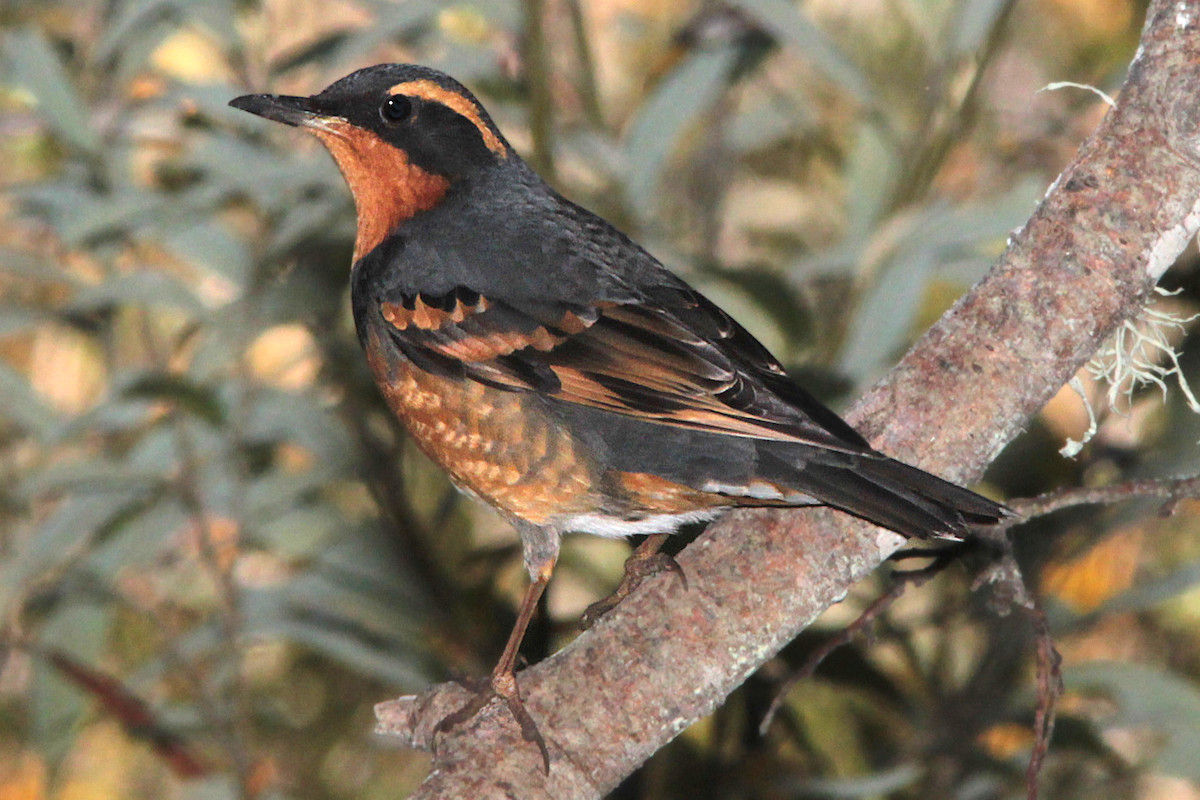Although most people associate Alaska with a frozen tundra, it actually has several distinct ecosystems and hosts a wide range of bird species. Several of these species migrate to Alaska for the summer or winter, while others stay throughout the year. In this article, we’ll investigate 24 of the most common backyard birds in Alaska, learn about each species, and see what we can do to help.
Then I’ll teach you how to entice them to your property and give you a crash course in the ten distinct styles of bird feeders available. Finally, I’ll mention some of the best local birding groups and a few birdwatching hot spots in Alaska.
How many different species of wild birds are in Alaska?
It’s hard to say how many different bird species live in North America, the United States, or even in Alaska, because there are so many. Nonetheless, at least 530 different kinds of birds have been observed in the state of Alaska, according to the Alaska Checklist Committee.
For the purposes of this article, we’ll focus on some of the species that may be seen in urban areas and backyards in Alaska, but we won’t go into detail about them.
24 COMMON BACKYARD BIRDS IN ALASKA
In Alaska, we’ll take a look at 24 different backyard bird species, as well as some migrants. These are some of the birds that are most likely to frequent backyards in Alaska, but they aren’t all of the species in the state, or even close to it. Let’s get started!
1. BLACK-CAPPED CHICKADEE

Scientific name: Poecile atricapillus
Length: 4.7-5.9 in
Weight: 0.3-0.5 oz
Wingspan: 6.3-8.3 in
Because of their black cap and black bib, chickadees are tiny little birds with rounded bodies that are extremely easy to recognize. Their underbodies are fluffy and light, and their cheeks are solid white. Their wings and backs are blackish gray. They’re rather prevalent around bird feeders, and they run back and forth from one to the next to cover their feeder. Chickadees are typically the first birds I notice at my yard’s new feeder, and they may be quite bold for their size!
Throughout southern Alaska and portions of the interior, black-capped chickadees can be found all year.
Most seed feeders will be visited by Chickadees, who will offer black sunflower seeds and mixed seed blends.
2. AMERICAN CROW

Scientific name: Corvus brachyrhynchos
Length: 15.8-20.9 in
Weight: 11.2-21.9 oz
Wingspan: 33.5-39.4 in
The color of American Crows is solid black, and they are quite big. Like their cousin the raven, they are also well-known for their problem-solving abilities. Crows will congregate in large numbers at the tree crests where they may get a birds-eye view of everything below them. The roost will yell out if an owl or hawk arrives, alerting everyone to the presence of danger.
Southern and south-central Alaska are home to crows all year.
The American Crow is an omnivorous species that does not feed at birdfeeders because they are too big. They will, however, pick through your trash if you are not careful.
3. CANADA JAY

Scientific name: Perisoreus canadensis
Length: 9.8 – 11.4 in
Weight: 2.0 – 3.0 oz
The Canada Jay is a master of the cold, as proven by his name. These can be found all year round, from the far north to the far south of Canada. They breed in the cold and dark of February and March, and their home is high elevation boreal forests. Unlike many birds in the area that wait for late spring, this is an intriguing decision to incubate eggs during one of the coldest phases of the year.
The body of both sexes is mostly gray, with a blacker back and white head with a black band at the nape. All over, juveniles are black. When it comes to human interaction, these jays are inquisitive and fearless, constantly on the lookout for food.
In northern and interior Alaska’s boreal forests, you’ll always find the Canada Jay year round.
The Canada Jay enjoys eating seeds and suet at bird feeders.
4. BLACK-BILLED MAGPIE

Scientific name: Pica hudsonia
Length: 17.7-23.6 in
Weight: 5.1-7.4 oz
Wingspan: 22.1-24.0 in
The black-billed magpie is a magpie that resembles a jay in size, but resembles a crow in appearance. Metallic blue along their wings, with a black head, chest, and back; bright white shoulder and sides; and a long tail.
Fruit, grain, insects, small mammals, carrion, and eggs make up their varied diet. They’ve been spotted hanging out on the backs of moose and deer, combing through their hair for ticks. These colorful birds frequent trees and on fenceposts, and they aren’t bashful. They may make a lot of noise when they’re in groups.
In southern Alaska, black-billed magpies may be seen year-round.
Black-billed magpies may visit yards, although they prefer open rangeland. On a platform feeder, offer them sunflower seeds and peanuts, or leave out oranges halves to entice them. Offer them suet as well.
5. WHITE-CROWNED SPARROW
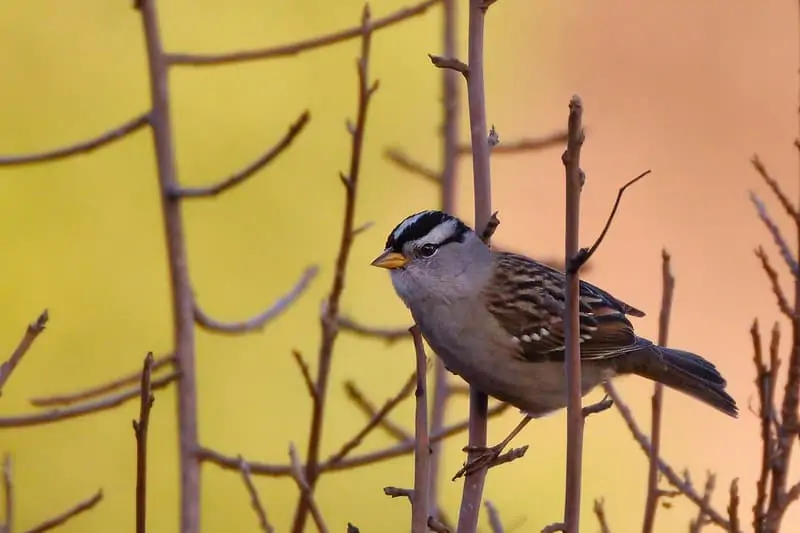
Scientific name: Zonotrichia leucophrys
Length: 5.9-6.3 in
Weight: 0.9-1.0 oz
Wingspan: 8.3-9.4 in
White-crowned sparrows migrate back and forth across the United States throughout the winter, spending their summers far north in Canada and Alaska. White-crowned sparrows have a contrast black and white striped head, while the remainder of their face, chest, and belly are a neutral buffy brown-gray color. They are one of the easier sparrows to identify.
In fields, on roadways and trails, they enjoy foraging. These sparrows will visit bird feeders, but they are more likely to pick up spilled seed on the ground.
Sparrows will only be seen throughout the spring-summer in most of Alaska. During the winter months near the southeast / inner passage, however, they are only seen on rare occasions.
Feeders are often visited by white-crowned sparrows, who like to collect fallen seed beneath them. Sunflower, millet, and mixed seed blends are available.
6. PINE GROSBEAK

Scientific name: Pinicola enucleator
Length: 7.9 – 9.8 in
Wingspan: 13.0 in
Large, chunky birds such as Pine Grosbeaks Males have rosy-red on their head, breast, and back, and their bodies are gray. Instead of the head and rump, females have yellow. They have a thick, black beak that’s ideal for extracting spruce, pine, and juniper seeds. It’s robust yet short.
Insects are included into their diet during the summer, but they primarily eat seeds, fruits, and buds. You can see them not only in North America, but also across northern Eurasia, making them one of the few backyard birds. In higher elevations, they live in open conifer woodlands.
Throughout most of central and southern Alaska, Pine Grosbeaks may be found year-round.
During the winter, providing black oil sunflower or hulled sunflower seeds may attract Pine Grosbeaks to bird feeders. Remember that these are bigger birds, so they’ll want a platform feeder with huge perches or a hopper or tube feeder.
7. AMERICAN ROBIN

Scientific name: Turdus migratorius
Length: 7.9-11.0 in
Weight: 2.7-3.0 oz
Wingspan: 12.2-15.8 in
Robins are common in gardens, and they’re typically seen hopping around looking for worms and other invertebrates. They do not usually eat seeds, despite feeding at bird feeders on occasion. They’re easy to identify because of their brilliant orange round bellies, yellow beaks, and size. From dawn till dusk, they are a common pair of vocalists.
During the summer months, robins are found all over Alaska, and on the extreme southern shore, they may be seen year-round.
Attract seed feeders with meal worms, indigenous fruit-bearing plants, or a bird bath since American Robins are uncommon visitors to seed feeders.
8. RED-BREASTED NUTHATCH

Scientific name: Sitta canadensis
Length: 4.3 in
Weight: 0.3-0.5 oz
Wingspan: 7.1-7.9 in
The back, chest, and belly of these little nuthatches are dark gray, while the face is boldly black and white striped. These are very active and quick birds that spend the majority of their time hopping around beneath the bark of trees in search of insects. They’ll use backyard nest boxes as well as tree cavities to breed.
Only the southern Alaskan shore and the inner passage are home to red-breasted Nuthatches all year.
Feeders are a favorite destination for red-breasted Nuthatches. Sunflower seeds, peanuts, and suet are all options.
9. BOREAL CHICKADEE
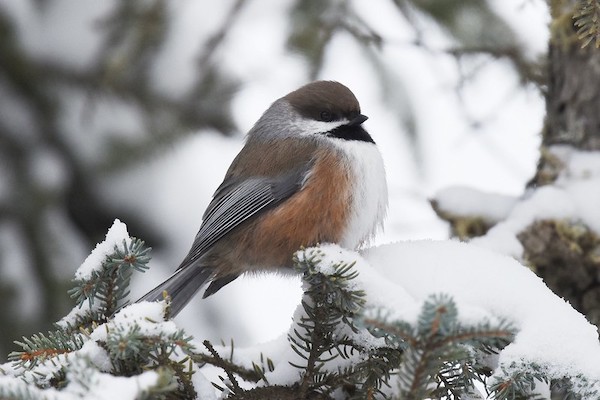
Scientific name: Poecile hudsonicus
Length: 4.9 – 5.5 in
Weight: 0.3-0.4 oz
Little spherical birds called Boreal Chickadees They stand out from other chickadees because of their coloring, which is distinctive. The black chin, brown head, gray wings, white belly, and rusty brown sides are all visible on these birds.
These chickadees dwell in the boreal woodlands of the north and are named for this. The best state in the United States is Alaska. They are rarely seen farther south than Canada, so you must go to see them. During the summer months, they store a lot of food to help them get through the winter when food is scarce.
Throughout the year, boreal chickadees can be found in southern and interior Alaska’s evergreen woods.
feeders are attractive to Thick-billed Chickadees, and a nest box may entice them to visit your yard.
10. HAIRY WOODPECKER

Scientific name: Leuconotopicus villosus
Length: 7.1-10.2 in
Weight: 1.4-3.4 oz
Wingspan: 13.0-16.1 in
Except from their larger size and a few other key features, Hairy Woodpeckers and Downy Woodpeckers have little to differentiate them. They are virtually usually discovered in the same areas of the nation as each other, and both have identical markings. The Hairy Woodpecker, on the other hand, does not visit a bird feeder as often as the Downy’s do.
Throughout central and southern Alaska, Hairy Woodpeckers may be seen all year, but some migrate south in the winter. White areas of their plumage in Alaska may appear dark brown.
Hairy Woodpeckers will eat suet and seed feeders, but they are not as common as Downy Woodpeckers.
11. COMMON REDPOLL
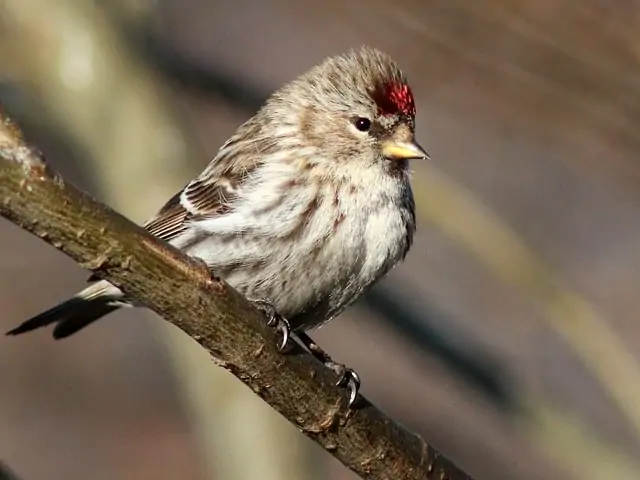
Scientific name: Acanthis flammea
Length: 4.7 – 5.5 in
Weight: 0.4 – 0.7 oz
Wingspan: 7.5 – 8.7 in
The Common Redpoll is a finch species that is small and attractive. They have a brown-streaked body, a yellow beak, and a red patch on top of their head, which has a rounded shape. The breast of males is pinkish in color.
These northern birds spend the summer in the far north, then migrate to Canada for the winter. They’ve been seen digging a hole in the snow to create a comfortable sleeping location overnight.
Throughout the year, Common Redpolls may be found in the southern half of the state, but only during the summer in northern Alaska.
During the winter, Common Redpolls will feed at birdfeeders and prefer thistle-sized seeds.
12. FOX SPARROW
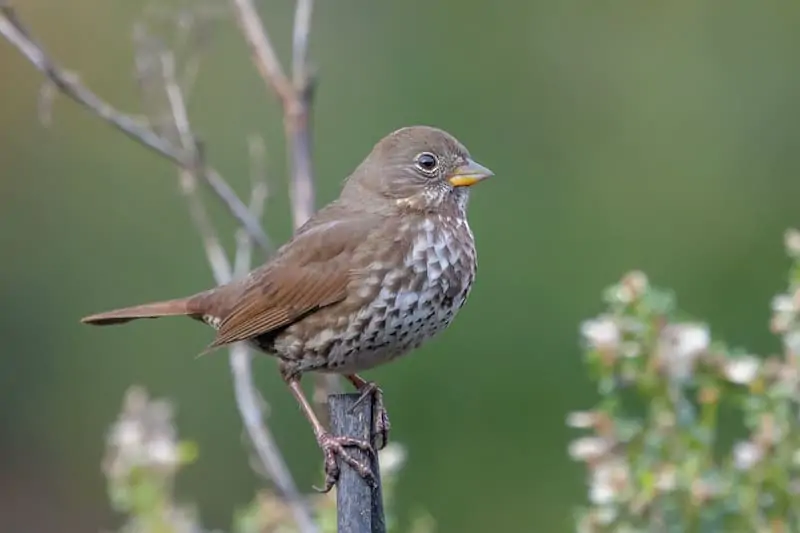
Scientific name: Passerella iliaca
Length: 5.9 – 7.5 in
Weight: 0.9 – 1.6 oz
Wingspan: 10.5 – 11.4 in
The rich crimson and orange coat of a fox inspired the name of Fox Sparrows. The coloring, however, is only seen in certain fox sparrows. Red, Sooty, Slate-colored, and Thick-billed are the four distinct color groups that may vary considerably from one another. They’re a common sparrow that hides in thickets and brush, rather than seeking out company.
During the breeding season, most of Alaska is home to Fox Sparrows. The southern United States is where these sparrows will go. During the winter, there is no need to wear Along the inland passage, there is a tiny population that stays year-round.
They’re more likely to visit fruiting shrubs than feeders in the backyard, where they can pick at the seed that has fallen to the ground.
13. BROWN CREEPER

Scientific name: Certhia americana
Length: 4.7 – 5.5 in
Weight: 0.2 – 0.3 oz
Wingspan: 6.7 – 7.9 in
The Brown Creeper is a tiny bird that sits on enormous tree limbs and slowly climbs up, picking at the cracks in the bark for insects. Despite the fact that their backs are well disguised with bark, they are a rather frequent species.
The nests of the Brown Creepers are a little different. They build a hammock-shaped nest behind a big, loose piece of bark and prefer dead or dying trees. This species is occasionally employed by researchers to assess the health of the ecosystem in regions with heavy logging because it is so reliant on mature trees for food.
Southern Alaska is home to these birds all year.
Brown Creepers are unusual in that they don’t visit bird feeders, but in the winter, suet may draw them in.
14. SONG SPARROW

Scientific name: Melospiza melodia
Length: 4.7-6.7 in
Weight: 0.4-1.9 oz
Wingspan: 7.1-9.4 in
The plumage of song Sparrows varies somewhat depending on the area and may be found across most of North America. These sparrows have a dark breast and chest with a pale belly, and their back and wings are generally brown. In the Western United States, song sparrows It may seem, as a result of the Streaking, darker, grayer, and heavier. Males of this species sing both to attract females and to defend their territory.
Along the southern shore and the Aleutian islands, Song Sparrows can be found year-round.
Bird feeders are sometimes visited by Song Sparrows, who enjoy mixed seeds and sunflower seeds.
15. RED-CROSSBILL

Scientific name: Loxia curvirostra
It’s simple to see how this bird got its name. The Red Crossbill’s distinctive crisscrossed beak allows them to break into unopened conifer cones. Other birds that must wait until the cones open before they can investigate for seeds have an disadvantage against them. Females are yellow, with males having red skin and gray wings.
Conifer seeds provide the majority of their food, so they can breed at any time of year as long as there is a plentiful supply of food. Southeastern Alaska is home to them all year.
A bird feeder is unlikely to attract Crossbills. If you have cone-producing evergreen trees in your yard, you’re more likely to see them.
16. DOWNY WOODPECKER
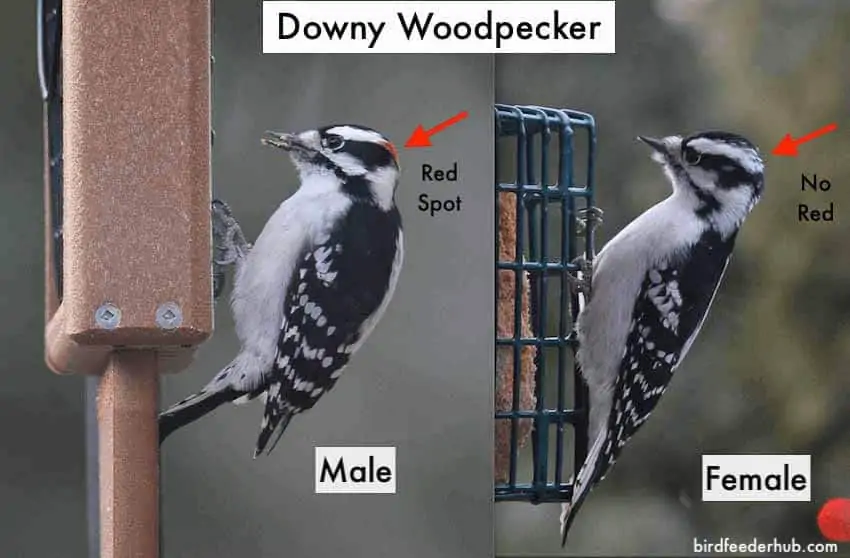
Scientific name: Picoides pubescens
Length: 5.5-6.7 in
Weight: 0.7-1.0 oz
Wingspan: 9.8-11.8 in
Downy’s are one of the first species I see on a new bird feeder, and they are the tiniest woodpeckers in North America. Their white underbodies, black wings with white dots, black and white striped heads, and a red spot on the back of their heads (in males, females have no red) make them easy to spot. Downy’s are smaller than Hairy Woodpeckers, despite their visual resemblance.
Throughout southern and western Alaska, the Downy Woodpecker can be found all year. In species from the Pacific, their white feathers may seem duller.
In most kinds of bird feeders, Downy Woodpeckers are common. Mixed seed, black sunflower seed, and suet can all be offered.
17. BOHEMIAN WAXWING
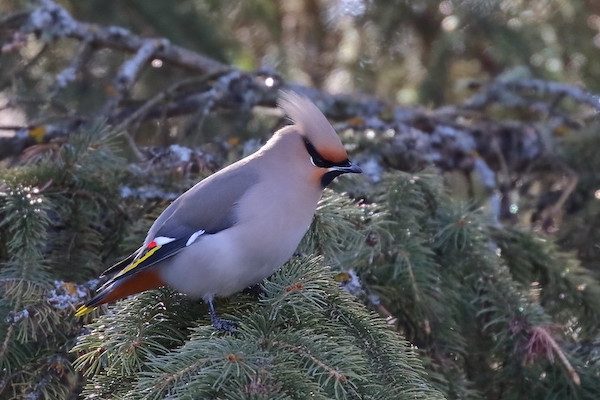
Scientific name: Bombycilla garrulus
Length: 6.3 – 7.5 in
Weight: 1.6 – 2.4 oz
Wingspan: 13.0 in
The unique coloring of Bohemian Waxwings makes them easy to identify. The head and chest of these medium-sized birds are tawny brown, the wings are dark gray, and the tail is yellow. Their ferocious black eye mask and enormous floppy brown crest give them an wild appearance. Little, red, waxy nubs at the tips of their wings gave the waxwings their name. These can be difficult to discern, and no one knows what they’re supposed to do. They may help you find a partner.
One of the few North American birds that can subsist on fruit alone for many months is the Bohemian waxwing, which enjoys fruit. In the summer, they supplement their diet with insects, although compared to other birds, they can consume a larger quantity of fruit.
Throughout the summer months, Bohemian Waxwings can be found across most of Alaska.
Seed feeders aren’t for Bohemian Waxwings. Native trees and shrubs that produce small fruits and berries may be used to entice them to your yard.
18. NORTHERN FLICKER

Scientific name: Colaptes auratus
Length: 11.0-12.2 in
Weight: 3.9-5.6 oz
Wingspan: 16.5-20.1 in
In the United States, these medium to huge woodpeckers are found in gardens and yards, but not at feeders. They’re also one of the most vibrant birds in North America, in my opinion. Flickers prefer to hunt insects on the ground rather than in the trees, which sets them apart from other woodpeckers.
The black patches on their bellies, solid black bib, red patch on the back of their necks, and barred black and gray wings are all identifying features. A black mustache can be seen on males. The “yellow-shafted” variety, which has bright yellow feathers on the underside of its wings and tail, can be found in Alaska.
Throughout the summer, Northern Flickers go to Alaska, then return to lower America for the winter.
While other woodpecker species may visit feeders more often, northern flickers will still come to suet feeders. You may observe them digging for insects around leaf piles in your yard.
19. DARK-EYED JUNCO
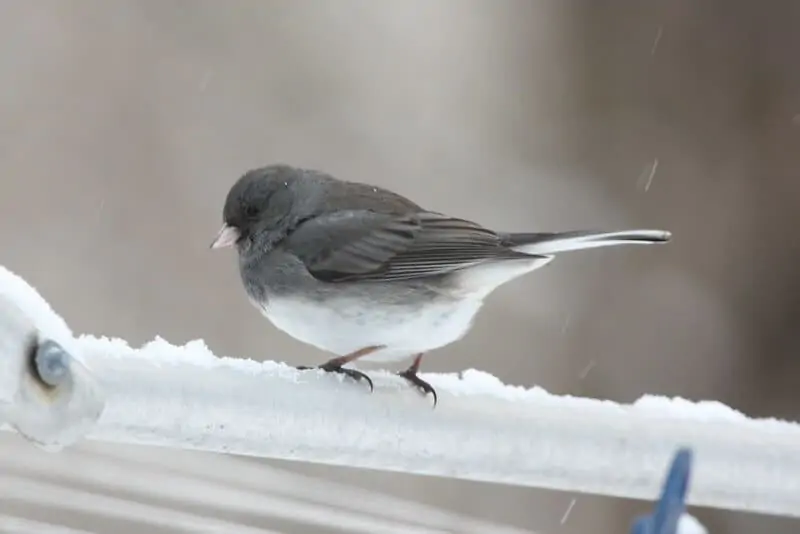
Scientific name: Junco hyemalis
Length: 5.5-6.3 in
Weight: 0.6-1.1 oz
Wingspan: 7.1-9.8 in
Throughout the United States, Juncos come in a variety of colors. In the eastern United States, They have a black head, chest, back, wings, and tail in Alaska and Canada. They have a white belly that extends all the way to their tail’s bottom. Females can range in color from gray to buffy brown. The pale pink beak and roundish body shape of junco are two excellent features to look for when identifying them. They can often be seen hopping around on the ground in forests and wooded areas, where they are most common.
The southern coast of Alaska is home to dark-eyed Juncos all year, but they are primarily summer birds in the rest of the state.
Juncos will go to feeders on occasion, but they usually prefer to eat ground seed that other birds have left behind. Mixed seeds are something they enjoy.
20. CHESTNUT-BACKED CHICKADEE

Scientific name: Poecile rufescens
Length: 3.9-4.7 in
Weight: 0.3-0.4 oz
Wingspan: 7.5 in
Because of their “black cap” and black bib, chickadees are tiny little birds that are simple to identify. From the west coast of North America to Alaska, this western bird may be found. It has a chestnut back and sides in the northern parts of its range, such as Alaska. The nests of these chickadees, which they gather from numerous creatures such as rabbits and deer, are filled with a lot of fur. Around bird feeders, they are quick and inquisitive birds that come off as rather fearless.
Around the southern coast, you may see Chestnut-backed Chickadees year-round.
Most seed feeders will be visited by chickadees, who will offer black sunflower seeds and mixed seed blends.
21. PINE SISKIN
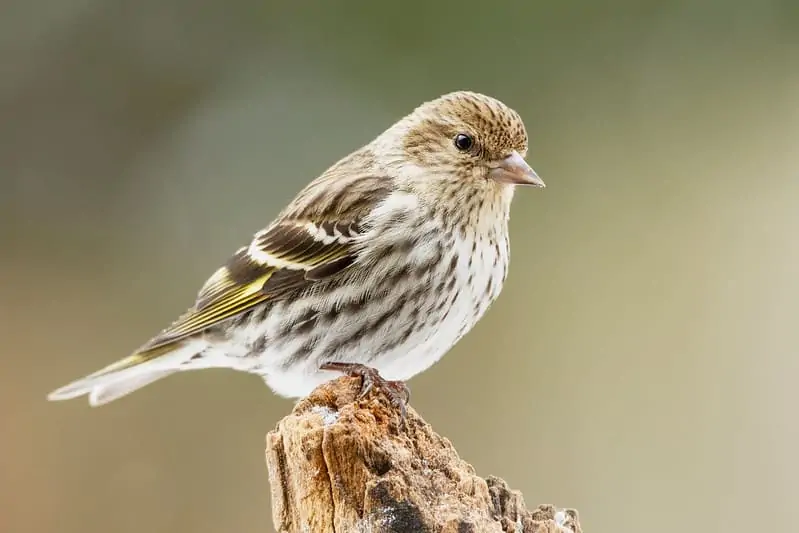
Scientific name: Spinus pinus
Length: 4.3-5.5 in
Weight: 0.4-0.6 oz
Wingspan: 7.1-8.7 in
The little finch family Pine Siskins has a pointed beak that is small in size. They’re brown and white, with streaks on their wings that make them resemble female house finches. The yellow (of varying brightness) on the wings and sides of the Pine Siskin’s tails will always be present. They are nomads and move around a lot every winter after good seed crops, with conifer seeds serving as their primary food source.
All year, Pine Siskins may be seen along the southern coast. The summers of a migratory population are spent in Alaska’s interior.
Nyjer (thistle) feeders are popular with Pine Siskins, who may also eat millet or hulled sunflower.
22. VARIED THRUSH

Scientific name: Ixoreus naevius
Length: 7.5-10.2 in
Weight: 2.3-3.5 oz
Wingspan: 13.4-15.0 in
A big, robin-sized songbird called the Varied Thrush. Their bright orange throat, eybrow stripe, belly, and wingbars make it difficult to mistake their plumage. Males are a dark blue-gray color while females are more of a gray-brown color on their face, back, and tail. In the summer, they feed on insects and arthropods foraged from leaf litter on the forest floor and are birds of the dense Pacific northwest woods. Fruits and berries, acorns, and nuts are added to their diet during the winter.
The Varied Thrush stays around all year in a few small areas of the state. Nonetheless, they are only seen during the spring and summer in Alaska, for the most part.
During the winter, the Varied Thrush is most likely to visit backyards. Ground feeders, as well as falling from hanging feeders, such as hulled sunflower seed, may be eaten. Planting native shrubs that produce berries in the winter can also attract them.
23. STELLER’S JAY

Scientific name: Cyanocitta stelleri
Length: 11.8-13.4 in
Weight: 3.5-4.9 oz
Wingspan: 17.3 in
Jay, Steiner’s bird, is a bright specimen! The top half is brownish-black, while the bottom half is bright blue. They are big birds. During courting or in defense, these jay raise a huge crest that they may flick and show off to dramatic purpose. Evergreen woods are their primary habitat, although they may be found in campgrounds, parks, and yards across their range.
In Alaska, year-round, Steller’s Jays may be spotted, although they are only located in the southeast and are rather uncommon.
Put out peanuts, big seeds, and nuts to attract the Steller’s Jay to birdfeeders.
24. COMMON RAVEN
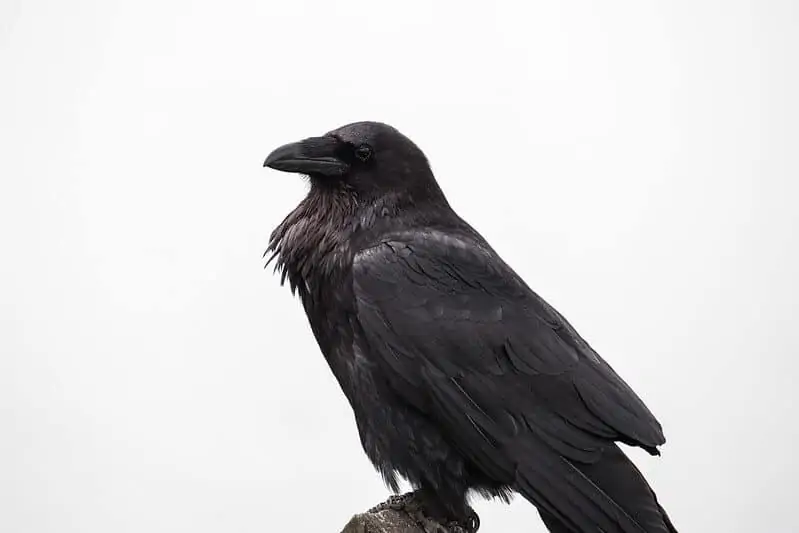
Scientific name: Corvus corax
Length: 22.1-27.2 in
Weight: 24.3-57.3 oz
Wingspan: 45.7-46.5 in
Solid black in color and massive in size, Common Ravens are rather frightening. These crows are also recognized for their exceptional problem-solving abilities. Living alongside human activity or in complete isolation, they seem to be equally at ease. The most typical sound of a raven is a series of croaks, which can produce a broad variety of sounds.
Throughout all of Alaska, ravens may be seen year-round.
Omnivorous common ravens are too big to reach bird feeders and therefore do not visit them. However, be careful about throwing away or feeding your pet outdoors.
HOW TO ATTRACT BIRDS TO YOUR YARD
Are you trying to attract some of these birds to your yard? Take a look at the five basic principles, starting with the most obvious.
1. PUT OUT BIRD FEEDERS
A bird feeder or two is the finest and most simple strategy to capture birds in your yard. A basic tube feeder, hopper feeder, platform feeder, or window feeder is a good place to start. For each of these, there are ideas below.
2. ADD A WATER SOURCE
A terra cotta flower pot saucer, like this one, is a decent option for a pedestal birdbath-style bath like the one on Amazon. Birds need water not only for bathing but also for drinking, so adding a water fountain to your yard will increase your likelihood of attracting them. Moreover, since flowing water attracts the birds to visit the pool more, a solar fountain may be added.
3. OFFER BIRDHOUSES
If placed in the correct location and at the correct time of year, many bird species will readily take up residence in birdhouses. Among the most commonly desired birds for birdhouses are Eastern Bluebirds. A mating pair of bluebirds inspected this birdhouse the same day I put it in the yard, and they were impressed.
4. PROVIDE SHELTER
When the birds sense danger, make sure that your yard has trees, bushes, and shrubs that they can dart back and forth to. Their major defense against predators is this. If your yard is in a development with no mature trees, try to include some landscaping elements that will allow birds to explore your yard safely.
5. ADD NATIVE PLANTS
Having native plants that produce nuts, berries, and seeds will only help you attract more birds for many birds that eat them. Additionally, since most songbirds feed insects to their hatchlings, native plants promote caterpillars and other insects that help many birds and support nesting birds. Invasive and non-native flora that may compete with native flora should be avoided.
10 DIFFERENT TYPES OF BIRD FEEDERS
Here are 10 of the most common bird feeders people set up in their yards.
- Hopper feeders are named after the hopper in the center, which holds the bird seed. Birds can land on and eat from the perches on the sides. To keep the seed dry, many hopper feeders are shaped like a house and covered on top. For this sort of feeder, use black sunflower seeds or a combination of birdseed. This is one of my favorite hopper feeders, and it’s squirrel-proof.
- Platform feeders are open on top and can be hung from a tree or hook, or pole-mounted. They are sometimes called tray feeders. They’re simple to set up and ideal for feeding a wide range of birds. Every animal in your yard that can reach them will eat from them, however they are completely open. For this type of feeder, use black sunflower seeds or mixed birdseed. In the moment, I’m utilizing this platform feeder in my yard.
- Tube feeders are simply clear plastic tube-shaped bird feeders that you can purchase at any store. They may hold anything from a few cups of seed to 5 pounds or more. These are great since they allow you to seed your seed whenever it’s needed, while also keeping it fresh and dry. Tube feeders are used by a variety of birds. With tube feeders, you may utilize black sunflower seeds and mixed seeds. This squirrel proof tube feeder is made by Squirrel Buster and is one of their best models on the market.
- Suet feeders are used to feed suet cakes to one kind of bird. They are a very basic notion, generally constructed of metal wire cages with a tail-prop for bigger birds. During the winter, when birds are seeking high-fat foods, suet feeders are common targets for woodpeckers, who visit them frequently. I recommend the Pileated and Northern Flicker for bigger woodpeckers, such as a suet feeder with a long tail prop.
- Small bird feeders known as window feeders are suction-cup-attached devices that attach to a glass window. They’re open on top and you simply dump the seed into the tray area to replenish them, similar to tray feeders. These feeders are very simple to use, and they’re great for anybody who doesn’t have a large yard since they attract a variety of species. This type of feeder may be used with black sunflower seeds or a combination of birdseed. On Amazon, this is by far the most popular window feeder, and it’s also the most popular bird feeder overall.
- Thistle feeders, sometimes known as Nyjer feeders, are specialized bird feeders that are particularly suited for thistle seed. Birds in the finch family, which includes the American Goldfinch and House Finch, are among the main types of birds attracted to thistle feeders. Thistle feeders are often circular in shape and feature tiny holes along the circumference of the circle, which allows thistle to be picked out. Droll Yankees has a really good thistle feeder.
- Tray feeders that sit on the ground level are known as ground feeders. Birds like Mourning Doves and Juncos, as well as squirrels, raccoons, and other kinds of ground animal, will adore them. This kind of feeder requires black sunflower seeds or a combination of birdseed. This recycled plastic ground feeder is a great option for you.
- Another kind of specialty feeder for one sort of bird, orioles, is the Oriole feeder. The feeder is usually orange in color, with little plastic or glass dishes for holding jelly that orioles like placed on it. Another treat that orioles enjoy is the ability to affix orange halves on the feeder. A simple oriole feeder with four jelly trays can hold up to four orange halves.
- Hummingbird feeders, sometimes known as hummingbird feeders, are designed to extract sugar water from hummingbirds. I frequently see Downy Woodpeckers at my feeder, despite the fact that they are meant for hummingbirds. For instructions on how to make hummingbird nectar without boiling the water, read this article. There’s no need to spend a lot of money on a hummingbird feeder since they’re so simple and inexpensive.
- Peanut feeders are tube-shaped and often made of metal wire mesh material. They are comparable to thistle feeders in design. To allow for whole unshelled or shelled peanuts to pass through the holes, the holes in the wire mesh are spaced much farther apart. These feeders should be filled with peanuts and attract birds like Blue Jays. This squirrel feeder by Squirrel Buster is the best way to keep squirrels out of your peanut feeder. This simple one will suffice.
BIRD WATCHING IN ALASKA
If you want to go outside of your own backyard for your hobby, Alaska is a great state for birding. If you want to get more involved, the Alaska Audubon Society hosts meetups, seminars, field excursions, and birding tours.
Take a look at this list I’ve put together of popular birding sites in Alaska if you’re an Alaska resident who’d like to add some new species to your life list.
